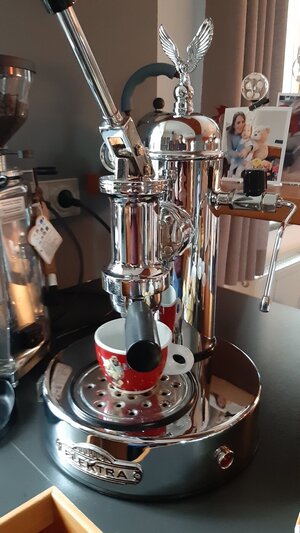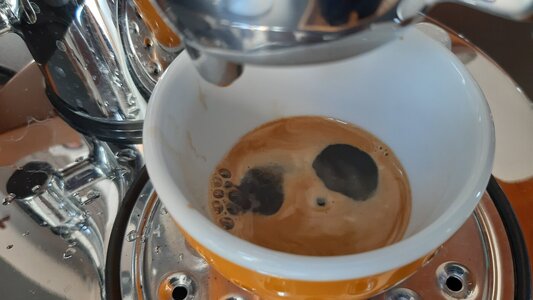Make one‘s mouth drop open, Johann, your work is from another planet. Simply fabulous, you can only learn from it. Das ist hohe Schule.
-

Win a Free Custom Engraved Brass Coin!!!
As a way to introduce our brass coins to the community, we will raffle off a free coin during the month of August. Follow link ABOVE for instructions for entering.
-

PRE-ORDER SHIPS IN SCALE TODAY!
The beloved Ships in Scale Magazine is back and charting a new course for 2026!
Discover new skills, new techniques, and new inspirations in every issue.
NOTE THAT OUR FIRST ISSUE WILL BE JAN/FEB 2026
You are using an out of date browser. It may not display this or other websites correctly.
You should upgrade or use an alternative browser.
You should upgrade or use an alternative browser.
La Créole 1827 by archjofo - Scale 1/48 - French corvette
- Joined
- Nov 10, 2019
- Messages
- 469
- Points
- 373

Hi Adi,
thanks for your nice comment.
Ratlines for the topmast shrouds
The topmast shrouds were thinner than the lower shrouds (comparison on the model: Fore mast shrouds ø 1.08 mm / fore topmast shrouds ø 0.66 mm), their ratlines are also to be made with smaller diameters in proportion, which is the result of earlier research.
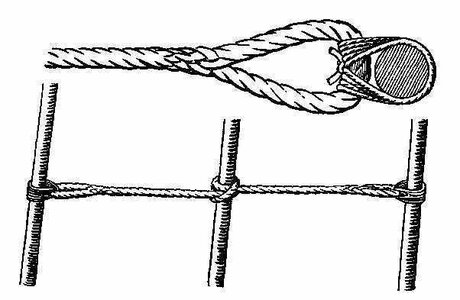
Some time ago, I tried to clarify whether the required eye splices could be made with a thickness of ø 0.25 mm. For this purpose I made a splicing tool with a smaller diameter ø 0.8 mm, as shown in the next picture.
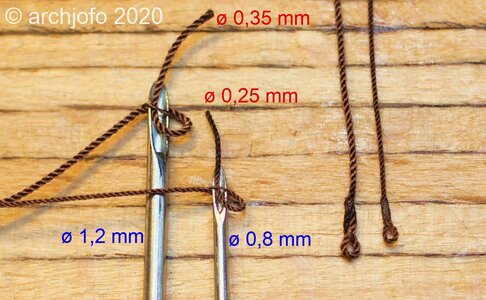
The fake splice (2x sticking through) with a dew thickness of ø 0.25 mm was already quite successful at that time.
In the following picture you can see the comparison of the ratlines thickness again.I don't like the simpler alternative version with knots, because it is too thick and doesn't correspond to the original version.
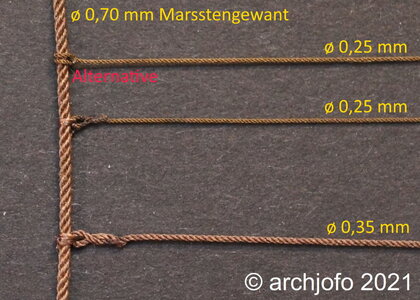
In the meantime I have found the time and muse to make these filigree ratlines with the fake splice directly on the model. It has to be said that this is an extremely difficult job, but it can be done. In my opinion, the result speaks for itself. In this respect it is worth the effort.
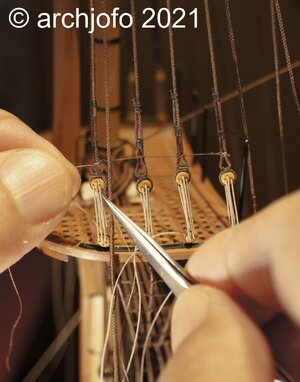
But now we will continue with mizzen topmast stay. I still have to find out how it was attached.
I would be very grateful for any information.
See you soon ...
Translated with www.DeepL.com/Translator (free version)
thanks for your nice comment.
Ratlines for the topmast shrouds
The topmast shrouds were thinner than the lower shrouds (comparison on the model: Fore mast shrouds ø 1.08 mm / fore topmast shrouds ø 0.66 mm), their ratlines are also to be made with smaller diameters in proportion, which is the result of earlier research.

Some time ago, I tried to clarify whether the required eye splices could be made with a thickness of ø 0.25 mm. For this purpose I made a splicing tool with a smaller diameter ø 0.8 mm, as shown in the next picture.

The fake splice (2x sticking through) with a dew thickness of ø 0.25 mm was already quite successful at that time.
In the following picture you can see the comparison of the ratlines thickness again.I don't like the simpler alternative version with knots, because it is too thick and doesn't correspond to the original version.

In the meantime I have found the time and muse to make these filigree ratlines with the fake splice directly on the model. It has to be said that this is an extremely difficult job, but it can be done. In my opinion, the result speaks for itself. In this respect it is worth the effort.

But now we will continue with mizzen topmast stay. I still have to find out how it was attached.
I would be very grateful for any information.
See you soon ...
Translated with www.DeepL.com/Translator (free version)
Hi Johann,
your build and the pictures of it are fantastic.
Cheers, Alexander
your build and the pictures of it are fantastic.
Cheers, Alexander
Good day Johann,
Great , exelent job You show us!!!
Jast pleasure to watch it.
But what about mizzen top mast stay? What could be cpecific there... is there some special arrangements for your stay?
Great , exelent job You show us!!!
Jast pleasure to watch it.
But what about mizzen top mast stay? What could be cpecific there... is there some special arrangements for your stay?
- Joined
- Nov 10, 2019
- Messages
- 469
- Points
- 373

Good day,
In the books 1&2 Modeles Historiques, nothing usefull for you?
Just in case )), I think You already checked it...
)), I think You already checked it...
I saw there are a few good photoes of preventer stays arrangements, but unfortunately only of it upper part , and not exactly mizzen topmast...
In the books 1&2 Modeles Historiques, nothing usefull for you?
Just in case
I saw there are a few good photoes of preventer stays arrangements, but unfortunately only of it upper part , and not exactly mizzen topmast...
Hallo Johann,
did you change now the scale you make the rigging on an 1:24 scale model?
Or how can you do this?
Some short questions, only that I understand it correctly:
1) you are now making the ratlines with these knots, or? (red arrow)
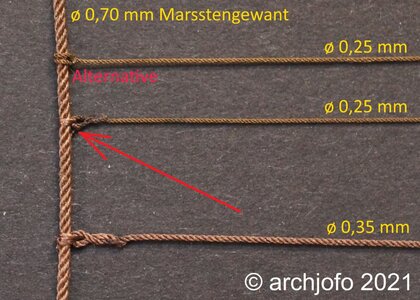
First of all - it is looking beautiful - also the different and correct size (diameter) of the ratlines - BTW: I love the color of your material
2) But now my second question related to the ratline production:
Due to the fact, that each ratline has at the ends an eye splice, you have to make a defined length before you install the ratline at the shrouds
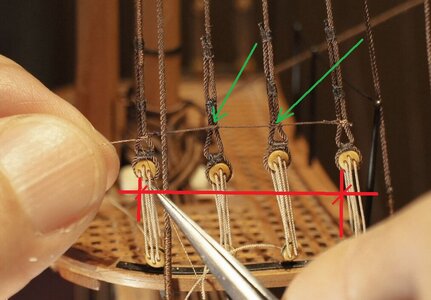
It is the red distance + two times the necessary length for the intermediate knots (red arrows)
So you prepare the ratline before in the correct length and install afterwards - and due to the fact, that with the height on the mast or topmast the distance between th first and the last shroud is getting shorter, you have also to make each ratline slightly shorter..... Does I interpret your work correctly?
Anyhow => WOW !!!
did you change now the scale you make the rigging on an 1:24 scale model?
Or how can you do this?
Some short questions, only that I understand it correctly:
1) you are now making the ratlines with these knots, or? (red arrow)

First of all - it is looking beautiful - also the different and correct size (diameter) of the ratlines - BTW: I love the color of your material
2) But now my second question related to the ratline production:
Due to the fact, that each ratline has at the ends an eye splice, you have to make a defined length before you install the ratline at the shrouds

It is the red distance + two times the necessary length for the intermediate knots (red arrows)
So you prepare the ratline before in the correct length and install afterwards - and due to the fact, that with the height on the mast or topmast the distance between th first and the last shroud is getting shorter, you have also to make each ratline slightly shorter..... Does I interpret your work correctly?
Anyhow => WOW !!!
- Joined
- Nov 10, 2019
- Messages
- 469
- Points
- 373

@kirill4
Thank you for your input.
I have already looked there, but have not found anything useful yet.
Maybe I'll have to look again more closely.
@Uwek
Hello Uwe,
first of all thank you for your interest in my work.
Now to your questions:
No, I still work with the scale 1:48.
to 1) Yes, as with the lower shrouds, only smaller.
to 2) No, no defined length is produced, that would not be calculable correctly due to the ratline knots.
It simply works like this:
I make an eye splice and start binding in at the right shroud. Before arriving at the last shroud, I make the eye splice directly on the model and then it fits naturally.
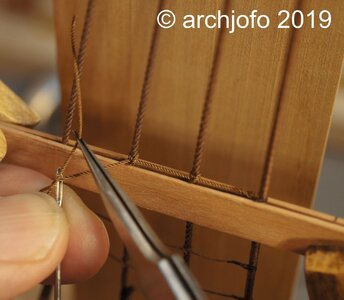
I hope that I have explained it clearly.
Thank you for your input.
I have already looked there, but have not found anything useful yet.
Maybe I'll have to look again more closely.
@Uwek
Hello Uwe,
first of all thank you for your interest in my work.
Now to your questions:
No, I still work with the scale 1:48.
to 1) Yes, as with the lower shrouds, only smaller.
to 2) No, no defined length is produced, that would not be calculable correctly due to the ratline knots.
It simply works like this:
I make an eye splice and start binding in at the right shroud. Before arriving at the last shroud, I make the eye splice directly on the model and then it fits naturally.

I hope that I have explained it clearly.
Last edited:
- Joined
- Nov 10, 2019
- Messages
- 469
- Points
- 373

@Steef66
Hi Stephan,
Thank you for your interest and the positive comment.
Hi,
here it goes on after a small creative break:
In the meantime I have made the ropes for the main topmast preventer stay (Ø 0.63 mm) and mizzen topmast preventer stay (Ø 0.50 mm).
In principle, these are attached as shown in the following sketch.
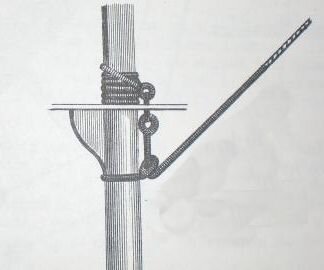
Source: Internet unknown
This method of attachment was described in the monograph by J. Boudriot. I hope that I have interpreted it correctly.
Accordingly, the collars were prepared with thimbles. At the corresponding places the stays are served.
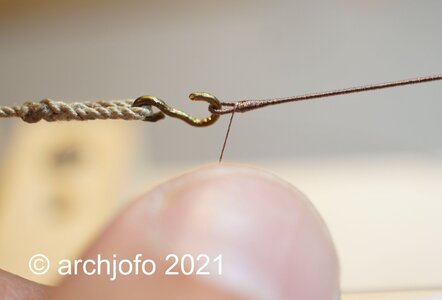
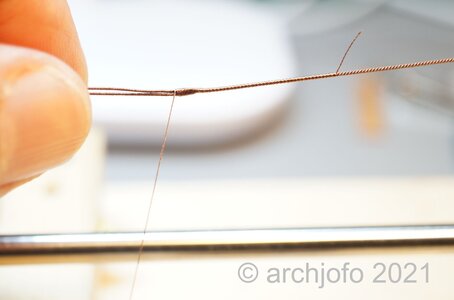
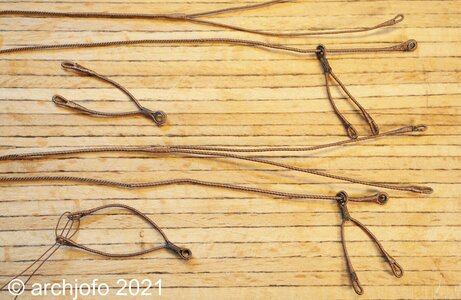
Shortly I will show how they are then mounted on the model.
Hi Stephan,
Thank you for your interest and the positive comment.
Hi,
here it goes on after a small creative break:
In the meantime I have made the ropes for the main topmast preventer stay (Ø 0.63 mm) and mizzen topmast preventer stay (Ø 0.50 mm).
In principle, these are attached as shown in the following sketch.

Source: Internet unknown
This method of attachment was described in the monograph by J. Boudriot. I hope that I have interpreted it correctly.
Accordingly, the collars were prepared with thimbles. At the corresponding places the stays are served.



Shortly I will show how they are then mounted on the model.
I love the colour and surface / texture of your ropes very much - which kind of yarn / strand are you using and which producer?
BTW: Great work as usual - I am looking forward to see these rigging elements installed
BTW: Great work as usual - I am looking forward to see these rigging elements installed
- Joined
- Nov 10, 2019
- Messages
- 469
- Points
- 373

@mati.n
Thank you for the explanation.
Nevertheless, I would like to say the following about silk:
Silk is not without problems as far as durability is concerned. There was a comprehensive and interesting discussion about this at MSW LINK. I learned that there are museum models with silk rigging that are very old.
In the end, I decided in favour of silk despite the concerns about durability.
Since I adore natural fabrics, synthetic fibres are out of the question for me.
Thank you for the explanation.
Nevertheless, I would like to say the following about silk:
Silk is not without problems as far as durability is concerned. There was a comprehensive and interesting discussion about this at MSW LINK. I learned that there are museum models with silk rigging that are very old.
In the end, I decided in favour of silk despite the concerns about durability.
Since I adore natural fabrics, synthetic fibres are out of the question for me.
- Joined
- Aug 8, 2019
- Messages
- 5,521
- Points
- 738

I have read the discussion on msw. What do you do to the problem of unravel of the silk rope, like the admin told you about polyester rope? That problem you can solve by backing your rope after you made it. (5 min. On 175 degree Celsius). How is the silk?@mati.n
Thank you for the explanation.
Nevertheless, I would like to say the following about silk:
Silk is not without problems as far as durability is concerned. There was a comprehensive and interesting discussion about this at MSW LINK. I learned that there are museum models with silk rigging that are very old.
In the end, I decided in favour of silk despite the concerns about durability.
Since I adore natural fabrics, synthetic fibres are out of the question for me.
- Joined
- Nov 10, 2019
- Messages
- 469
- Points
- 373

@Steef66
Hi,
that's not a problem for me at all. I fix the ends with instant adhesive.
Here it continues:
Hello,
I have not yet come to the assembly of the mizzen topmast preventer stay and main mast preventer stay. I still have to finish these steps and will of course report on them.
At the moment I am dealing with the detail clarification for the following stays:
Mizzen topgallant stay and main topgallant stay - Étai mât de perruche et Étai grand mât de perroquet
The mizzen topgallant stay of La Créole had a diameter of 22 mm, the main topgallant stay 28 mm (recalculated according to G. Lacroix method).
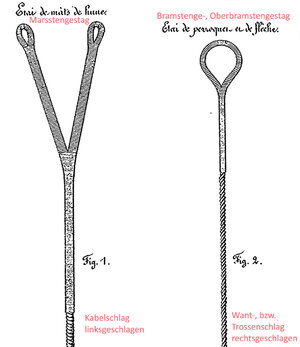
Source: Atlas du Génie Maritime, Annexe Pl. 1
These stays did not have open eyes like the top mast stays (Fig. 1). The collar was spliced directly to the stay (Fig. 2) and served accordingly. Based on the illustration in the atlas (1860), I assume that these stays, also due to their small diameters, were made as hawser laid rope. Unfortunately, I did not find corresponding information in the monograph on La Créole, also not regarding the continuations and fixations on the respective tops. Also on the picture material available to me I cannot see any indications in this respect.
Only to the mizzen topgallant stay I have read in the monograph that this is led down to Mars via a single block, which was attached to the mast cap. About the attachment of the stay again nothing concrete can be taken from the description.
Therefore a few questions arise in this connection, which I try to bring to a clarification.
In addition first the following representation for the overview of these two stays:
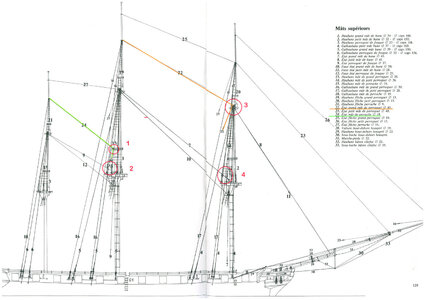
Source: Monograph "La Creole" by J. Boudriot, p. 129
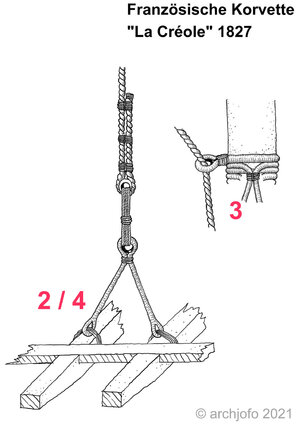
My research gave, as shown graphically above, from my point of view a conceivable fixing possibility for these stays (numbers of the overview assigned) on the respective crosstrees. In my opinion, the main topgallant stay could be forwarded by means of a collar (number 3) with a thimble.
To what extent this way of fixing and forwarding the stays for the La Créole is historically correct, I could not find out.
Therefore I would be grateful for any hints and your valued opinion.
See you soon ...
Hi,
that's not a problem for me at all. I fix the ends with instant adhesive.
Here it continues:
Hello,
I have not yet come to the assembly of the mizzen topmast preventer stay and main mast preventer stay. I still have to finish these steps and will of course report on them.
At the moment I am dealing with the detail clarification for the following stays:
Mizzen topgallant stay and main topgallant stay - Étai mât de perruche et Étai grand mât de perroquet
The mizzen topgallant stay of La Créole had a diameter of 22 mm, the main topgallant stay 28 mm (recalculated according to G. Lacroix method).

Source: Atlas du Génie Maritime, Annexe Pl. 1
These stays did not have open eyes like the top mast stays (Fig. 1). The collar was spliced directly to the stay (Fig. 2) and served accordingly. Based on the illustration in the atlas (1860), I assume that these stays, also due to their small diameters, were made as hawser laid rope. Unfortunately, I did not find corresponding information in the monograph on La Créole, also not regarding the continuations and fixations on the respective tops. Also on the picture material available to me I cannot see any indications in this respect.
Only to the mizzen topgallant stay I have read in the monograph that this is led down to Mars via a single block, which was attached to the mast cap. About the attachment of the stay again nothing concrete can be taken from the description.
Therefore a few questions arise in this connection, which I try to bring to a clarification.
In addition first the following representation for the overview of these two stays:

Source: Monograph "La Creole" by J. Boudriot, p. 129

My research gave, as shown graphically above, from my point of view a conceivable fixing possibility for these stays (numbers of the overview assigned) on the respective crosstrees. In my opinion, the main topgallant stay could be forwarded by means of a collar (number 3) with a thimble.
To what extent this way of fixing and forwarding the stays for the La Créole is historically correct, I could not find out.
Therefore I would be grateful for any hints and your valued opinion.
See you soon ...
- Joined
- Aug 8, 2019
- Messages
- 5,521
- Points
- 738

thanks. But this makes your work more difficult to make eyes or grommets because the rope wants to unravel. RespectI fix the ends with instant adhesive
But it's worth it when you look at the end result.





